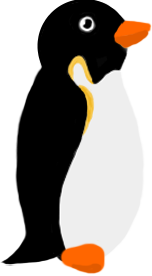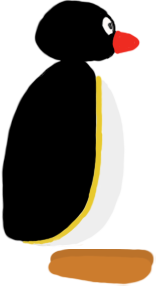Interact
- Clara Schroeder

- Oct 29, 2020
- 5 min read
Statement of Intent:
Our animation aims to create a multi user interaction which illustrates the need for cooperation to solve greater environmental issues, such as cleaning up our oceans. The goal for our interaction is to foster the value of cooperation in our users, prompting them to partake in collective action and step back from individualist mindsets which have created the environmental issues we face today. The animation will emulate the experience of working together to protect life in our oceans.
Our animation aims to subvert the innocent world of our childhood friend, Pingu, and brings him into a dystopian reality. The seemingly untouched arctic is juxtaposed with swaths of rubbish and pollution, creating a sense of extremism that our ocean pollution could even affect this far away, white and pristine place. In this Black Mirror esque episode of Pingu, we must help him navigate a world of pollution and work together to balance the values of our society, preventing Pingu, and us as a manifestation of nature, from falling to our demise.
Process:
The assignment brief challenged us to form pairs, one person taking the role of the art director which I chose to be, and the other as coder which was my team mate Jordan. We would undertake a process of creative interpretation and abstraction to code a simple interactive experience, using processing, that seeks to inform the 'user' how they can play a role in changing the status quo of a United Nations statistic.
The Sustainable Development Goal #14 aims to conserve and sustainably use the oceans, seas and marine resources for sustainable development. From this goal, we chose the statistic that 40 per cent of the ocean is heavily affected by human activities (including pollution, depleted fisheries, and loss of coastal habitats) (UNDP. n.d.).
Research
Taking together previous research, a key theme we identified is that individualism is our detriment as human kind and catalyses the environmental issues we face today. Individualism is the underpinning value of our capitalist society and contributes to urbanisation, mass production and over consumption which impacts the ecological wellbeing of our oceans. These capitalist values have resulted in wicked problems such as our global environmental emergency (Juniper,2014).
To solve wicked problems we must partake in collectivist action and nurture a global community between humankind and the natural world.
Ideation
Our initial ideations explored how everyday people can end ocean pollution through actions such as political advocacy, using reusable products, as well as taking only pictures and leaving only footprints.
Additionally, we explored several visual representations of co-operation in goal oriented group work inspired by games such as Agari.o. We also explored representations of balance through the Yin Yang symbol in an ocean context.
Inspired by this piece from surrealist artist Christian Schloe named 'The Balance' (Schloe, n.d.) , we created an ideation in which a figure walks across a tightrope suspended above polluted waters. From either side of the pole we would suspend a representation of the values we must keep in balance in society, such as the natural world and convenience, to minimise our impact on the natural environment and live in harmony together. The animation would have two player inputs in which one player controls one value and vice versa, the goal of the interaction is to work together to allow our figure to cross the tightrope.
I drew this interaction several times to iterate perspective and ideate which objects the pole would be balancing. However, in the end we decided that placing the animation into a polluted ocean context was sufficient to carry the concept of balance across to the user.
Final ideation:
Our final iteration was to place the figure as a penguin crossing a tightrope between two icebergs suspended above polluted waters. Representing the figure as an animal allows for all users to identify with the main character of our interaction and fosters a deeper emotional connection to the narrative.

Case Study: Pingu
Pingu is a beloved Penguin who has greeted out TV screens since the 1990's. The Swiss claymation series for children follows a cheeky penguin and his adventures in Antarctica. Due to the show's lack of a real spoken language, Pingu reached international fame with children around the world saying his catchphrase "Noot Noot!".
As the art director, I decided to include Pingu as our main character in the animation to subvert the innocent TV show and bring it into a dystopian reality. In effect, we aim to extrapolate our statistic to show that if ocean degradation continues, penguins like Pingu soon may not have a home.
I chose to frame our final narrative as an episode of Pingu. In this episode Pingu has been out exploring and is walking back to his igloo, however, while he was out the connecting iceberg on his path has broken away because of global warming. The users must cooperate to help Pingu balance across a tightrope between the two icebergs to safely get him across and allow him to return home.

Image via: Kids Cartoon Youtube, 'Pingu'
Aesthetic Styling
To emphasise visual clarity and keep in theme with the Pingu aesthetics, I chose to draw the scene in a cartoon nature. This took me a few tries however after studying reference images by Natalia Darmoroz (2018) I found my footing. Additionally, I adapted our original penguin to look more like Pingu.
Inspiration image:

Image via: iStock, Natalie Darmoroz
Final Illustration:

To create greater clarity for the user, I designed a start, win and fail screen. The start screen outlines the context and rules of the interaction while the win screen shows pingu once he has crossed safely. The fail screen pops up when Pingu doesn't get across the tightrope and falls past his automatic beginning point. In the fail screen, Pingu has a tear in his eye and is covered in pollution.
I believe adding these screens helps to ground the animation in it's wider context of the statistic, they help explain the narrative to our users and show the consequences of how not co-operating and finding a balance in society can affect our natural environment.
Sound
The sound for our animation is crinkling plastic and water noises to add ambiance to the scene from ZAPSPLAT royalty free sounds.
Final Animation: Pingu And The Tight Rope
Reflection
Overall, I enjoyed working in a team and being able to bring insight from my artistic strengths to our final animation. Creating a dystopia Pingu episode as the narrative for our animation added a layer of depth and insight which enabled us to tie in our statistic back to the concept of a two player interaction, I believe this added great strength to our submission. Reflecting on my artistic process, I would like to have played around with the staging of the scene further.
This assignment has taught me the importance of having excellent team organisation and communication to make the duo dynamic run as smoothly as possible. I enjoyed working with Jordan and getting to know his workflow whilst being able to share mine.
In conclusion, I am proud of our team output and enjoyed the creative process of this assignment.
References:
Design Stack: A Blog about Art, Design and Architecture: Surreal Paintings—Balance of Mind and Heart. (n.d.). Retrieved October 29, 2020, from https://www.designstack.co/2015/03/surreal-paintings-balance-of-mind-and.html
Juniper, T. (2014, November 26). Capitalism v environment: Can greed ever be green? | Guardian Sustainable Business | The Guardian. https://www.theguardian.com/sustainable-business/2014/nov/26/capitalism-environment-green-greed-slow-life-symposium-tony-juniper
null, L. edited. (n.d.). Vector illustration of cartoon nature winter arctic landscape with... IStock. Retrieved October 29, 2020, from https://www.istockphoto.com/vector/vector-illustration-of-cartoon-nature-winter-arctic-landscape-with-iceberg-blue-pure-gm990633038-268495301
Prints by Christian Schloe. (n.d.). Society6. Retrieved October 29, 2020, from https://society6.com
Pingu, Trickfilmstudio (1990–2000)














































Comments